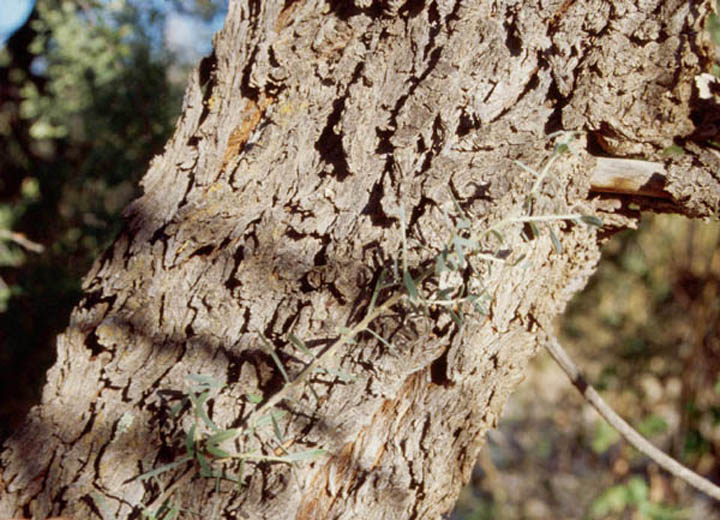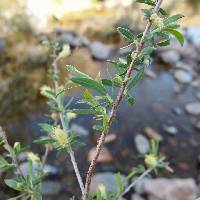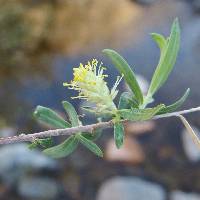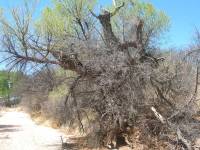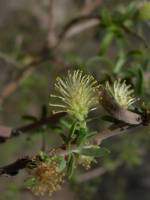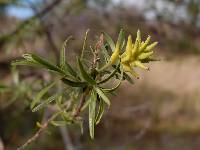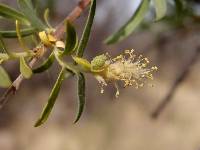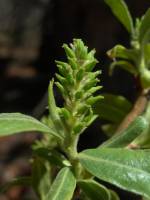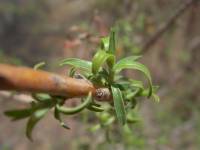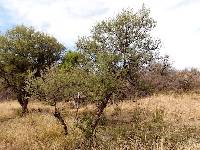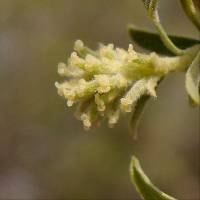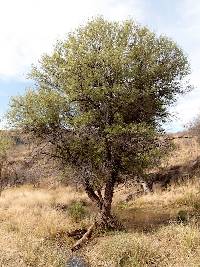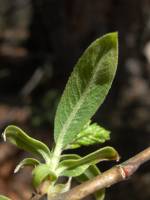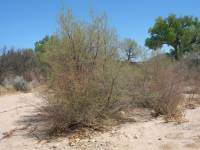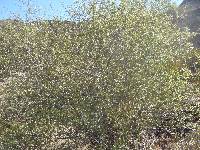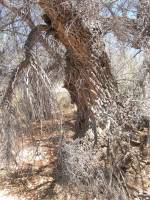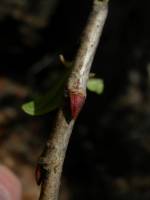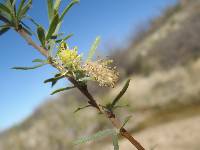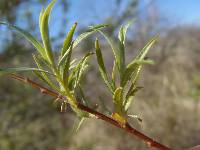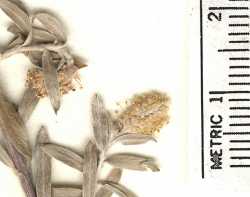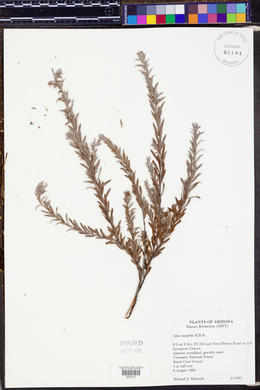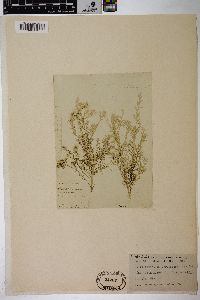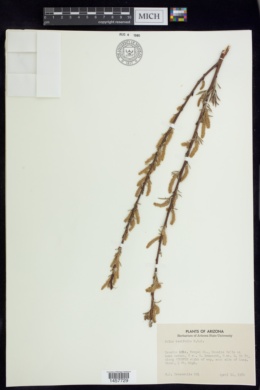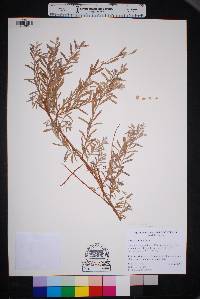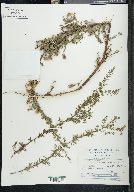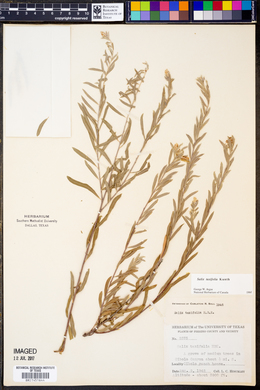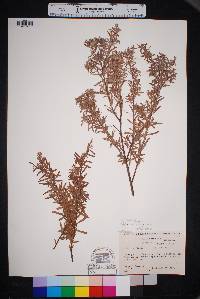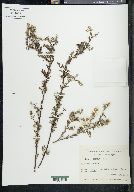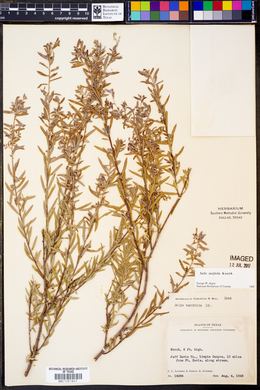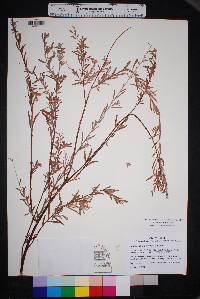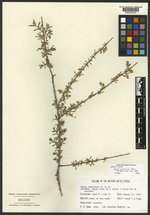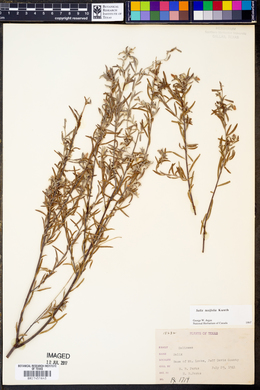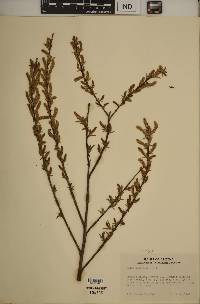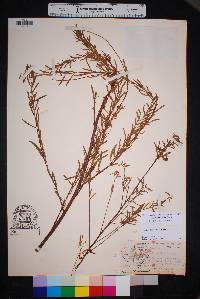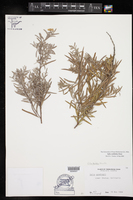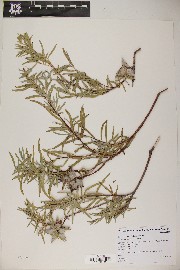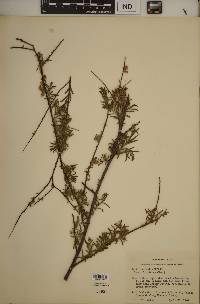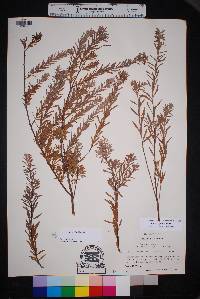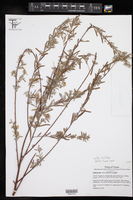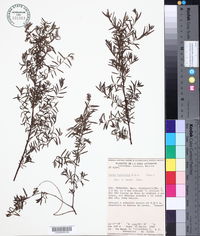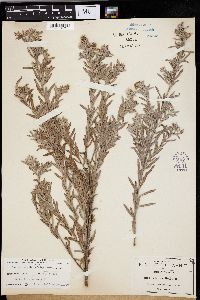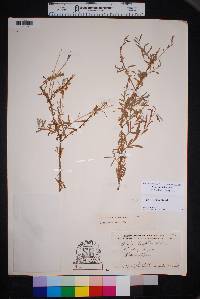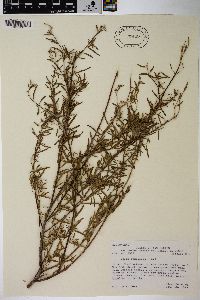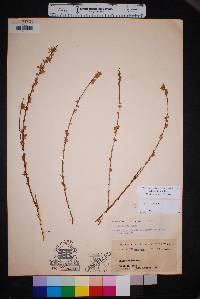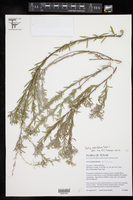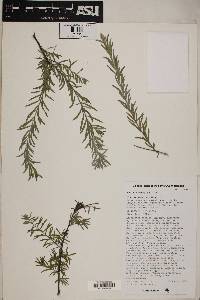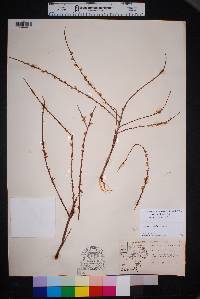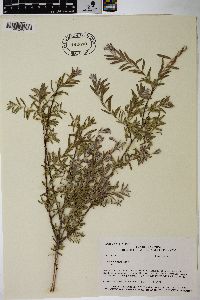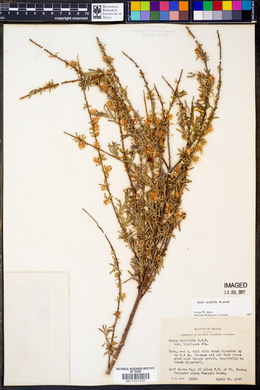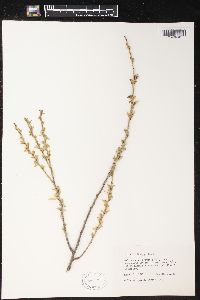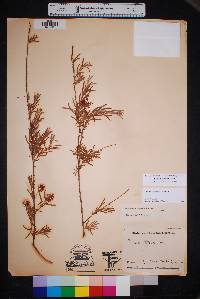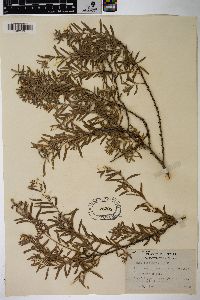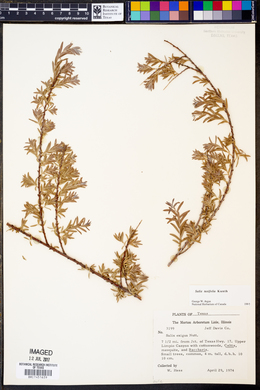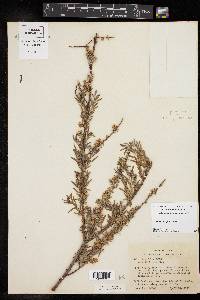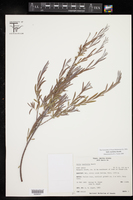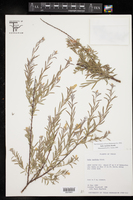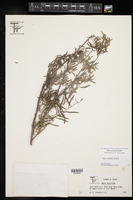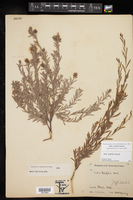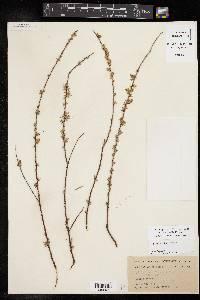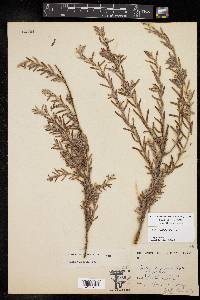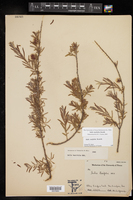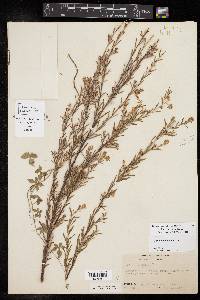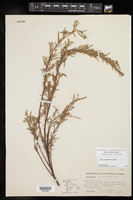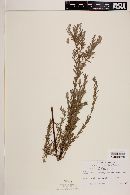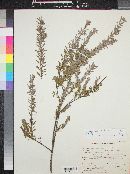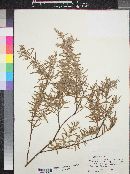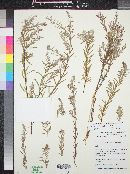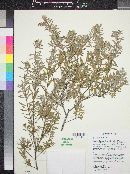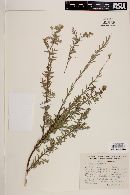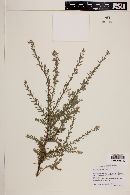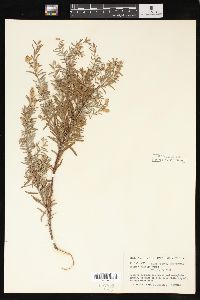Salix taxifolia
|
|
|
|
Family: Salicaceae
Yew-Leaf Willow, more...yewleaf willow (es: taráis, taray de río, sauce, palo de agua)
[Salix exilifolia R.D.Dorn, moreSalix taxifolia var. lejocarpa Anderss., Salix taxifolia var. limitanea I.M. Johnston, Salix taxifolia var. microphylla (Schltdl. & Cham.) C.K. Schneid., Salix taxifolia var. seriocarpa Anderss.] |
Shrubs or trees, 2-16 m. Stems: branches red-brown, yellow-brown, or gray-brown, hairy or glabrous; branchlets yellow-brown, very densely long-silky, villous, or short-silky to glabrescent. Leaves: stipules absent or rudimentary; petiole (sometimes deeply grooved adaxially) 0.2-1.5 mm, long- to short-silky adaxially; largest medial blade linear, lorate, or narrowly oblanceolate, 13-42 × 1.1-4.4 mm, 5.8-24.6 times as long as wide, base cuneate, margins flat, usually entire, rarely remotely spinulose-serrulate, apex acute to acuminate (apiculate), abaxial surface glaucous or not (sometimes obscured by hairs), densely long-silky, or villous to glabrescent, hairs appressed, straight, adaxial slightly glossy or dull, moderately densely long- or short-silky to glabrescent; proximal blade margins entire; juvenile blade yellowish green (color obscured by hairs), very densely long-silky abaxially. Catkins: staminate 6.5-18 × 4-7 mm, flowering branchlet 1-38(-75) mm; pistillate moderately densely or loosely flowered, slender or stout, 6-16 × 4-7 mm, flowering branchlet 8-13(-120) mm; floral bract 1.3-2.8 mm, apex acute or convex, toothed or entire (glandular-dotted), abaxially hairy throughout or proximally, hairs straight. Staminate flowers: abaxial nectary 0.1-0.6 mm, adaxial nectary oblong or narrowly oblong, 0.5-1.1 mm, nectaries distinct; filaments hairy on proximal 1/2 or basally; anthers 0.4-0.7 mm. Pistillate flowers: adaxial nectary square, narrowly oblong, ovate, or oblong, 0.4-1.4 mm, longer than stipe; stipe 0-0.3 mm; ovary pyriform, long-silky or pilose, beak gradually tapering to or bulged below styles; ovules 16-26 per ovary; styles 0-0.3 mm; stigmas slenderly cylindrical, 0.4-0.6 mm. Capsules 3-6 mm. Flowering throughout year, mostly early Mar-late Jun. Silty to sandy floodplains, gravelly arroyos, dry washes; 400-2000 m; Ariz., N.Mex., Tex.; Mexico (Baja California, Baja California Sur, Chiapas, Chihuahua, Coahuila, Sonora). The name Salix taxifolia is used here in the sense of G. W. Argus and C. L. McJannet (1992). R. D. Dorn (1998) used that name instead for what Argus and McJannet called S. microphylla, and for the present species used S. exilifolia. Dorn did not cite specimens of S. exilifolia, but Texas plants, possibly annotated by him, were mapped by B. L. Turner et al. (2003). The distribution of S. taxifolia parallels that of S. thurberi Rowlee, recognized here and by Dorn as a distinct species.
PLANTS: Tree or shrub to 16 m tall, clonal by root suckers. STEMS: branches red- to yellow- or gray-brown, silky becoming glabrous; branchlets yellow-brown, silky to villous becoming glabrous. LEAVES: stipules absent or rudimentary; petioles silky, 0.2-1.5 mm long; proximal leaves on vegetative or flowering branchlets entire or gland-dotted; young leaves silky, mature blade linear to ligulate or narrowly oblanceolate, 13-42 mm long, 1.1-4.4 mm wide, 5.8-24.6 times as long as wide, the lower surface glaucous or not, silky to villous becoming glabrous; upper surface shiny, silky becoming glabrous, the base acute; margins flat entire or gland-dotted, sometimes toothed, 1-6 glands per em, the apex acute, apiculate. INFLORESCENCE: coetaneous on short flowering branchlets or serotinous on long flowering branchlets; floral bracts tawny, 1.3-2.8 rom long, with straight hairs, the apices acute to obtuse; pistillate floral bracts deciduous after flowering. STAMINATE FLOWERS: in densely flowered catkins 7-20 mm long; flowering branchlets 1.5-290 mm long; stamens 2; filaments hairy; nectaries (0-)1 abaxial, 1 adaxial, broad to slender, 0.5-0.8 mm long. PISTILLATE FLOWERS: in densely to loosely flowered catkins 7-23 mm long; flowering branchlets 6-160 rom long; ovaries silky to pilose becoming glabrous; stigmas 0.44-0.6 mm long; styles 0-0.3 mm long; stipes 0-0.3 mm long; nectary slender to broad, 0.4-1.4 mm long, longer than stipe. NOTES: Warm temperate to subtropical; forests along streams; Cochise, Pima, Santa Cruz cos.; 750-1700 m (2300-5200 ft); Feb-Apr and throughout the year; s AZ to w TX; Baja C., to Coah., Mex. Related to S. microphylla Kunth which occurs in Mex. s to Guatemala. Figure 19. REFERENCES: Argus, George W. 1995. SalicaceaePart 2. Salix. J. Ariz. - Nev. Acad. Sci. 29(1): 39 Argus 1995, Benson and Darrow 1981 Common Name: yewleaf willow Duration: Perennial Nativity: Native Lifeform: Tree Wetland Status: FACW General: Slow growing large shrub or tree up to 12 m tall, trunk 50-70 cm diameter, bark rough and fissured. Leaves: Linear or linear-lanceolate, entire or dentate with few obscure teeth toward apices, 2-4 mm long by 1-4 mm wide, sessile or subsessile. Flowers: Catkins, yellow, deciduous, 2 separate stamens, stigmas .5-.7 mm long, slender. Fruits: Capsule, densely appressed-hairy, silky, reddish brown. Ecology: Found along streams and washes from 3,500-6,000 ft (1067-1829 m); flowers May-July. Distribution: s AZ, NM, s TX; south to s MEX, and in S. Amer. Notes: Distinguished by being a shrub to large tree with fissured bark; branches with silky hairs; and the narrowly-oblanceolate, silky-haired leaves with entire margins. Ethnobotany: Inner bark can be dried and ground into a powder made into bread, very bitter flavor, only considered a famine food. Bark contains salicin, which decomposes into salicylic acid (aspirin), used as anodyne, febrifuge, and as remedy for malaria. Etymology: Salix is the Latin name for willow, meaning -to leap or spring-, while taxifolia refers to the leaves being like yew, from the genus Taxus. Synonyms: Salix taxifolia var. leiocarpa, Salix taxifolia var. limitanea, Salix taxifolia var. seriocarpa Editor: SBuckley 2010, FSCoburn 2015 |
|
|
|

